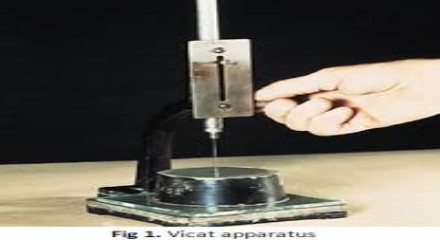Theory: Cement when mixed with water forms slurry which gradually becomes lesser and lesser plastic, and finally forms a hard mass. In this process a stage is obtained when the cement paste is sufficiently rigid to with stand a definite amount of pressure. The time to reach this stage is called setting time.
The setting time is divided into two parts: the initial setting time and the final setting time.Initial set is a stage where the cement paste stiffens to such an extent that the Vicat needle is not permitted to move down through the paste within 5 ± 0.5 mm measured from the bottom of the mould.
In other words, the cement paste starts losing its plasticity. The time elapsed between the moments that the water is added to the cement to the initial set is regarded as initial setting time.Any crack that may appear after initial set may not re-unite.
Final setting time is the time when the paste becomes so hard that the annular attachment to the needle under standard weight only makes an impression on the hardened cement paste.In order that the concrete may be mixed, transported and placed in position conveniently,it is necessary that the initial set of cement is not too quick. But after, it has been laid; the hardening should be rapid so that the structure can be made use of as early as possible.
For an ordinary Portland cement, the initial setting time should not be less than 30 minutes while the final setting time should not be more than 600 minutes.The setting time of the cement is influenced by factors such as: percentage of water,amount of kneading the paste, temperature and humidity of the environment. As per codal provisions; this test should be conducted at temperature of 27𝑜𝑜 ± 2𝑜𝑜 𝐶𝐶 and 90% humidity.
Flash set and false set are two terms, which are generally encountered in relation to the setting of cements. Flash set refers to the immediate stiffening of the cement paste due to violent reaction of pure 𝐶𝐶3𝐴𝐴 with water. To prevent flash set gypsum is added to the cement clinker during grinding. A phenomenon of abnormal and premature hardening of cement within a few minutes of mixing with water is termed as false set.
It differs from flash set in that no appreciable heat is evolved, and remixing the cement paste without addition of water restores plasticity of the paste and the concrete sets in normal manner without a loss of strength. This happens due to dehydration of gypsum when it comes in contact with excessively hot clinkers during grinding.
Objective: Determination of initial and final setting time of cement and determine whether the values satisfy IS standards.
Reference: IS 4031 (Part-5):1988
Apparatus: Vicat apparatus conforming to IS: 5513-1998; Weighing balance; Gauging trowel; measuring cylinder; stop watch.
Material: Ordinary Portland cement; Water.
Procedure:
- Prepare a uniform cement paste by gauging 400 g of cement with 0.85 times the water required to give a paste of standard consistency. The procedure of mixing and filling the mould is same as standard consistency.
- Start the stopwatch or note down the time when water is added to the cement. Determination of initial setting time:
- Place the test block confined in the mould and resting on the non-porous plate,under the rod bearing the initial setting needle (with cross section 1 mm2);lower the needle gently until it comes in contact with the surface of the test block and quickly release, allowing it to penetrate into the test block.
- Repeat this procedure until the needle, when brought in contact with the test block and released as described above, fails to pierce the block beyond 5.0 ±0.5 mm measured from the bottom of the mould. Note the time.
- The difference of time between operations (2) and (4) provides the initial setting time of cement.Determination of final setting time:
- Replace the initial setting needle of the Vicat apparatus by the needle with an annular attachment.
- The cement shall be considered as finally set when, upon applying the needle gently to the surface of the test block, the needle makes an impression thereon,while the attachment fails to do so.
- The interval of time between operation (2) and (7) provides the final setting time of cement.
Observations:
- Weight of given sample of cement is ___________ g.
- The normal consistency of a given sample of cement is ___________ %
- Volume of water addend (0.85 times the water required to give a paste of standard consistency) for preparation of test block ____________ ml
| Time in minutes : | |
| Height in mm fails to penetrate |
Initial setting time of cement (in min):
Final setting time (in min):
Conclusion:
The given sample of cement satisfied/ does not satisfy criterion for initial setting time.
The given sample of cement satisfied/ does not satisfy criterion for final setting time.
